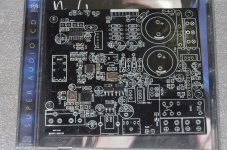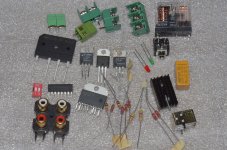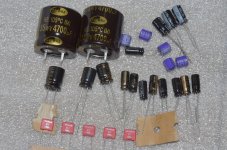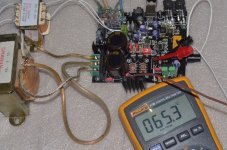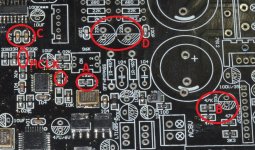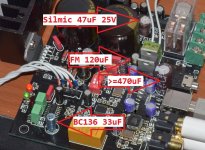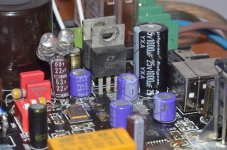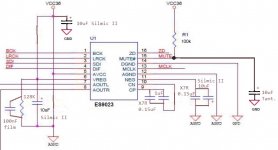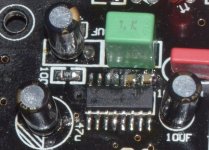Hello,
I buy a kit such as this for some fun.
ES9023DAC PCM2706 CS8421 192KHZ 24BIT LM4766 Omron USB DAC Kit WLX | eBay
I do not expect it is excellent.... but maybe it can be good. Anybody try ?
I expect routing is crazy because of the IC placing, and LM4766 amp have no regulator, so THD depend on transformer size / load.
If you have this kit, or have experience with this IC, please share the tips. I will put photos on when it is arrived.

Edit for summary.
PCB marking is not correct. It will give a bad sound. Here is important change. Kits not have 680R. It have 630R. The markings give distortion but change does not and gain is enough. Here is other changes.
Kit parts are not enough. For the speaker protection it need 4.7uF 16V, 330uF 25V + 100nF film bypass. For the LT1086, it need 1500uF 16V, 150uF 6.3V. Amp need 3 50V 100nF X7R (through hole not smt) for noise decouple on pins. DAC need 2 4700pF film capacitor to replace smt ceramic. It also need R8, 130k resistor. And 2 0603 100nF X7R on IC pins. Total for this is ~$7
DAC is very good despite 16 bit PCM2707. And PCM is easy to work with many devices and can have usb isolator such as the adum4160. CS8421 is good but the ES9023 is better with 50Mhz mclk. With 50MHz, 192Khz upsample sounds very good.
Amp is good. Extra ground return and decoupling on pins is good to to get lowest background noise, and the PCB have no other routing problem to fix for better sound. PCB is good - easy to solder/desolder many times.
Good for $50 ? I think yes for this money. For extra $10 on parts, also to get is 2 10,000uF 35V for more dynamic sound , and replace 180R at the base of LT1086 with 2 IR LED. Then for $5 more, replace 2 LM 3.3V and 1 LM 2.5V regulator with ADP151.
For $70, this is great value. Sound is above my expectation.
I buy a kit such as this for some fun.
ES9023DAC PCM2706 CS8421 192KHZ 24BIT LM4766 Omron USB DAC Kit WLX | eBay
I do not expect it is excellent.... but maybe it can be good. Anybody try ?
I expect routing is crazy because of the IC placing, and LM4766 amp have no regulator, so THD depend on transformer size / load.
If you have this kit, or have experience with this IC, please share the tips. I will put photos on when it is arrived.
Edit for summary.
PCB marking is not correct. It will give a bad sound. Here is important change. Kits not have 680R. It have 630R. The markings give distortion but change does not and gain is enough. Here is other changes.
Kit parts are not enough. For the speaker protection it need 4.7uF 16V, 330uF 25V + 100nF film bypass. For the LT1086, it need 1500uF 16V, 150uF 6.3V. Amp need 3 50V 100nF X7R (through hole not smt) for noise decouple on pins. DAC need 2 4700pF film capacitor to replace smt ceramic. It also need R8, 130k resistor. And 2 0603 100nF X7R on IC pins. Total for this is ~$7
DAC is very good despite 16 bit PCM2707. And PCM is easy to work with many devices and can have usb isolator such as the adum4160. CS8421 is good but the ES9023 is better with 50Mhz mclk. With 50MHz, 192Khz upsample sounds very good.
Amp is good. Extra ground return and decoupling on pins is good to to get lowest background noise, and the PCB have no other routing problem to fix for better sound. PCB is good - easy to solder/desolder many times.
Good for $50 ? I think yes for this money. For extra $10 on parts, also to get is 2 10,000uF 35V for more dynamic sound , and replace 180R at the base of LT1086 with 2 IR LED. Then for $5 more, replace 2 LM 3.3V and 1 LM 2.5V regulator with ADP151.
For $70, this is great value. Sound is above my expectation.
Last edited:
Looks a bit like a mess, but that does not need to say that much.
Some notes:
LM4766 does not need a perfect regulated supply, but it's power will be extremely limited with 15V +/- supply. (it is made for 30V +/-)
Looks like normal 7805 etc are used for the ES9023, that will NOT do.
CS8421 is used as receiver, ES9023 is in synchronous mode (without own clock). But the jitter specs of the CS8421 are way worse than the ES9023.
Some notes:
LM4766 does not need a perfect regulated supply, but it's power will be extremely limited with 15V +/- supply. (it is made for 30V +/-)
Looks like normal 7805 etc are used for the ES9023, that will NOT do.
CS8421 is used as receiver, ES9023 is in synchronous mode (without own clock). But the jitter specs of the CS8421 are way worse than the ES9023.
Hi,
I make ES9023 before.
http://www.diyaudio.com/forums/digi...9023-te7022-24-96-usb-dac-13.html#post3377776
I have SRC4192, SRC4392, AD1896 but not try CS8421.
Maybe I can try Keantoken CFP for the LM4766, but I prefer regulated. Maybe try 15-0-15 transformer for +/-22V unregulated.
I make ES9023 before.
http://www.diyaudio.com/forums/digi...9023-te7022-24-96-usb-dac-13.html#post3377776
I have SRC4192, SRC4392, AD1896 but not try CS8421.
Maybe I can try Keantoken CFP for the LM4766, but I prefer regulated. Maybe try 15-0-15 transformer for +/-22V unregulated.
I have SRC4192, SRC4392, AD1896 but not try CS8421.
Those three are exactly the same concerning sound quality, and all three much better than the CS8421. (actually still the best SRCs ever)
I read the same about CS8420 but I do not see any serious test for CS8421.
http://www.diyaudio.com/forums/digi...back-new-cs8421-high-res-asrc.html#post717775
http://www.diyaudio.com/forums/digital-line-level/209330-up-sampling-gigawork-dac.html#post2958108
It use 32 bit inside so maybe not so bad. And it is hardware control so it is friendly for me.
I see it has master and slave mode, and max clock is 27mhz. So I wonder how ES will sound from 27mhz clock, and if it can be better to use 50mhz for ES and divide in half for 25mhz for CS8421 with 74_163.
For the LM, I see for full power it wants +/-30V and 5.5A supply so 18-0-18 200VA or bigger transformer seems okay.
http://www.diyaudio.com/forums/digi...back-new-cs8421-high-res-asrc.html#post717775
http://www.diyaudio.com/forums/digital-line-level/209330-up-sampling-gigawork-dac.html#post2958108
It use 32 bit inside so maybe not so bad. And it is hardware control so it is friendly for me.
I see it has master and slave mode, and max clock is 27mhz. So I wonder how ES will sound from 27mhz clock, and if it can be better to use 50mhz for ES and divide in half for 25mhz for CS8421 with 74_163.
For the LM, I see for full power it wants +/-30V and 5.5A supply so 18-0-18 200VA or bigger transformer seems okay.
Last edited:
I look up some parts. I cannot find SRe 12Mhz EB212A (BB212A ?) oscillator - anyone know this ?
The main bulk capacitor is Samwha HE 4700uF 35V and it have 2.09 Amp ripple. Large Aluminum Electrolytic Capacitor Bridge rectifier D25XB is 3A with no heatsink, 25A with. So from datasheet, these component okay for about 20W, so a 15-0-15 100VA is okay for this. After capacitor is snubber uses 4R7 _ 100nF. Traces for power and ground are wide with some effort on star ground, so maybe it is okay amp design. I am not the expert for the chip amp but this all seem to be okay.
There is speaker protector C1237HA uses 7812 power.
ES9023 uses LT1086 for ~3.6V (178/100 resistor). I cannot find any R8. I measure from pin6 to GND and it is 17K. Output capacitor are marked 472 on PCB - look like ceramic.
CS8421 uses CTS CB3 oscillator. It is a low phase noise / jitter part.
PCM2707 uses SRe EB212A (maybe BB212A ?) oscillator. I cannot identify / find a datasheet for this.
I also cannot identify 3 smt regulator. I cannot read the markings clearly 2LG ? 2LZ ?
The main bulk capacitor is Samwha HE 4700uF 35V and it have 2.09 Amp ripple. Large Aluminum Electrolytic Capacitor Bridge rectifier D25XB is 3A with no heatsink, 25A with. So from datasheet, these component okay for about 20W, so a 15-0-15 100VA is okay for this. After capacitor is snubber uses 4R7 _ 100nF. Traces for power and ground are wide with some effort on star ground, so maybe it is okay amp design. I am not the expert for the chip amp but this all seem to be okay.
There is speaker protector C1237HA uses 7812 power.
ES9023 uses LT1086 for ~3.6V (178/100 resistor). I cannot find any R8. I measure from pin6 to GND and it is 17K. Output capacitor are marked 472 on PCB - look like ceramic.
CS8421 uses CTS CB3 oscillator. It is a low phase noise / jitter part.
PCM2707 uses SRe EB212A (maybe BB212A ?) oscillator. I cannot identify / find a datasheet for this.
I also cannot identify 3 smt regulator. I cannot read the markings clearly 2LG ? 2LZ ?
Last edited:
I have connected and test it is working.  Of course it must need the bigger heatsink etc for full power. It must burn in, but only 1 hour later... the bass is sounding good, the treble is a little bit crispy. It must play for some days before sound quality is known.
Of course it must need the bigger heatsink etc for full power. It must burn in, but only 1 hour later... the bass is sounding good, the treble is a little bit crispy. It must play for some days before sound quality is known.
Attachments
Some possible upgrades.
1. The dac power is from AC, rectified by 4 ON U1D diodes, and smoothed by 100uF next to headphone socket. This is 5mm spacing. It have 9.5V. I will use a bigger cap.
2. The es9023 uses 9.5V through lt1086 for 3.5V. There are many choices. I will try a tl431 zener to replace 180R for 3.75V out, or try two IR LED for ~3.65V. I choose this for low output impedance more than the lowest noise. I know ESS dac like low impedance supply.
3. The pcm2707 uses 3.3V. There is LT1086-5 pre-regulator for 5V. 3.3V is from 1117 regulator. The CS8421 use 3.3V and 2.5V from 5V pre-regulator. I will replace all with LP5907 or ADP151.
4. dac output is the corner RCA pair, always connected. I don't want it so I will cut the trace near the yellow relay. I will replace relay with Omron G6A-234P.
5. I will change/add some capacitors to improve the decoupling, and try for better sound after other changes. Definitely I will change the 4700pf ceramic on the ES9023 output. Although Wima look fake, they all test from 103nF to 105nF, so I am happy to keep them.
Sound is already better today. I am happy with this kit.
1. The dac power is from AC, rectified by 4 ON U1D diodes, and smoothed by 100uF next to headphone socket. This is 5mm spacing. It have 9.5V. I will use a bigger cap.
2. The es9023 uses 9.5V through lt1086 for 3.5V. There are many choices. I will try a tl431 zener to replace 180R for 3.75V out, or try two IR LED for ~3.65V. I choose this for low output impedance more than the lowest noise. I know ESS dac like low impedance supply.
3. The pcm2707 uses 3.3V. There is LT1086-5 pre-regulator for 5V. 3.3V is from 1117 regulator. The CS8421 use 3.3V and 2.5V from 5V pre-regulator. I will replace all with LP5907 or ADP151.
4. dac output is the corner RCA pair, always connected. I don't want it so I will cut the trace near the yellow relay. I will replace relay with Omron G6A-234P.
5. I will change/add some capacitors to improve the decoupling, and try for better sound after other changes. Definitely I will change the 4700pf ceramic on the ES9023 output. Although Wima look fake, they all test from 103nF to 105nF, so I am happy to keep them.
Sound is already better today. I am happy with this kit.
Last edited:
On previous posts:
I did not say CS8421 is bad, just that the specs are a bit below the popular SRC4192. But I'm confident that using the ES9023 in asynchronic modus, with a good 50MHz XO will be an improvement over feeding it with the CS8421.
The LT1086 is a quite noisy regulator (0.1mV noise), thus using low-ESR caps in front and after this regulator will improve things, using reference diodes instead of the adjustment resistor will help as well, but seems overkill.
The output of the PCM2707 is reclocked by the CS8421, thus not sensitve. But the CS8421 should receive very clean power, perhaps even more important than the ES9023, because all jitter on the CS8421 will remain in your output signal.
The the supply of the XO feeding the CS8421 should also be very clean!
The datasheet advices 1uF between the "NEG" and ground. But this is too small, use at least 2.2uF there, but rather 10uF. If the caps are mounted far away from the ES9023, it is good to place small 0603 or 0402 10-100nF caps directly on the pins of the ES9023, between AGND and NEG. Same would be nice between AVCC and AGND, but then you'll need a leaded cap, on top of the chip.
R8 shoud be present (+130k for 3.6V) otherwise the ES9023 clips on loud input. If the sound quality improves if you lower the volume of the input, (in Windows) then R8 is missiing.
I did not say CS8421 is bad, just that the specs are a bit below the popular SRC4192. But I'm confident that using the ES9023 in asynchronic modus, with a good 50MHz XO will be an improvement over feeding it with the CS8421.
2. The es9023 uses 9.5V through lt1086 for 3.5V. There are many choices. I will try a tl431 zener to replace 180R for 3.75V out, or try two IR LED for ~3.65V. I choose this for low output impedance more than the lowest noise. I know ESS dac like low impedance supply.
The LT1086 is a quite noisy regulator (0.1mV noise), thus using low-ESR caps in front and after this regulator will improve things, using reference diodes instead of the adjustment resistor will help as well, but seems overkill.
3. The pcm2707 uses 3.3V. There is LT1086-5 pre-regulator for 5V. 3.3V is from 1117 regulator. The CS8421 use 3.3V and 2.5V from 5V pre-regulator. I will replace all with LP5907 or ADP151.
The output of the PCM2707 is reclocked by the CS8421, thus not sensitve. But the CS8421 should receive very clean power, perhaps even more important than the ES9023, because all jitter on the CS8421 will remain in your output signal.
The the supply of the XO feeding the CS8421 should also be very clean!
The quality of the 1uF used for the chargepump is important.5. I will change/add some capacitors to improve the decoupling, and try for better sound after other changes. Definitely I will change the 4700pf ceramic on the ES9023 output. Although Wima look fake, they all test from 103nF to 105nF, so I am happy to keep them.
The datasheet advices 1uF between the "NEG" and ground. But this is too small, use at least 2.2uF there, but rather 10uF. If the caps are mounted far away from the ES9023, it is good to place small 0603 or 0402 10-100nF caps directly on the pins of the ES9023, between AGND and NEG. Same would be nice between AVCC and AGND, but then you'll need a leaded cap, on top of the chip.
R8 shoud be present (+130k for 3.6V) otherwise the ES9023 clips on loud input. If the sound quality improves if you lower the volume of the input, (in Windows) then R8 is missiing.
On previous posts:
I did not say CS8421 is bad, just that the specs are a bit below the popular SRC4192. But I'm confident that using the ES9023 in asynchronic modus, with a good 50MHz XO will be an improvement over feeding it with the CS8421.
CS8421 have very big variety in performance. 44.1-> 48 can do -171dB dynamic range and -177dB THD+N and PCM2707 16 bit becomes 24 bit. But 44.1 -> 192 is -130dB THD+N. Not special. This far, I prefer SRC to 96Khz.
I will try the bypass on pin6 to see if it is a benefit or no.
I agree that asynch can be better. I try the Epson SAW 50Mhz before.
The LT1086 is a quite noisy regulator (0.1mV noise), thus using low-ESR caps in front and after this regulator will improve things, using reference diodes instead of the adjustment resistor will help as well, but seems overkill.
Noise is % of output, and output depend on gain of 1.25V ref, so noise is increased by gain. But what if there is not any gain and we use a zener at the base.....then noise is not increase by gain, and noise is ~40uV + zener. It is clever use. There is much to read about such regulators and it might change your ideas about using low esr cap. The result is not always good.
Simple Voltage Regulators Part 2: Output Impedance
Using 3-pin regulators off-piste: part 1
http://tech.juaneda.com/en/articles/lm317.html
I see people recommend Micrel regulator but datasheet says it has 1uV per rt Hz, so it has over 200uV noise rms. I don't know why people recommend this part. Maybe someone can explain. maybe my math went wrong.
R8 shoud be present (+130k for 3.6V) otherwise the ES9023 clips on loud input. If the sound quality improves if you lower the volume of the input, (in Windows) then R8 is missiing.
PCM2707 is 16 bit only. It must not use windows volume control because it must decimate data and need the dithering. Anyway, I am using 140K right now for 3.5V because I did not like the sound for no R8.
I try the analogue input with the output of the Es9023 DAC (using te7022) I make before. It is very similar to the kit DAC. The weakness in this kit is the LM4766 power amplifier in the treble range.
Last edited:
I marked on the PCB for some changes.
B is low pass filter on output to detect DC offset into uc1237. I change the capacitor to Silmic 47uF 25V with 100nF film bypass.
D is filter in amplifier feedback circuit. The caps seem genuine Nichicon Muse and there film bypass.
C is DAC output filter. I change to pps film 0805 cap.
A is resistor connected to pin6 for bypass CS8421.
MCLK show impedance resistor and pin10 MCLK out resistor. Asynch MCLK can be connected on the pad after removal of the 33R. MCLK out must be turned off with high voltage through 47K resistor into pin10.
B is low pass filter on output to detect DC offset into uc1237. I change the capacitor to Silmic 47uF 25V with 100nF film bypass.
D is filter in amplifier feedback circuit. The caps seem genuine Nichicon Muse and there film bypass.
C is DAC output filter. I change to pps film 0805 cap.
A is resistor connected to pin6 for bypass CS8421.
MCLK show impedance resistor and pin10 MCLK out resistor. Asynch MCLK can be connected on the pad after removal of the 33R. MCLK out must be turned off with high voltage through 47K resistor into pin10.
Attachments
Last edited:
I make some small changes with 3 capacitors upgrades only and R8. Sound is not changed as I expect. I keep it playing continuously. Now there is even little distortion. Of course, I reverse the changes, but distortion continue. Amp sound is correct but now DAC sound is bad.
I find the distortion is made by oscillation. The LT1086 have not enough capacitance close by, and it must feed long trace (with big via) to ES9023. The PCB have only 10uF electrolytic marked for the output. It also have 10uF tantalum at the base. The datasheet says this is not good. And then there is the long trace also. So, this is bad.
So for the LT1086 output, I change the 10uF electro to 120uF Panasonic FM and also add smt 22uF tantalum in parallel on the opposite side of the PCB. The datasheet says this will guarantee stability.
Before the 2 LT regulator is 470uF. I make the mistake before. I did not see the PCB have markings to say this is 1500uF 16V, because marking is nearly under the LM1117. Kit have no such capacitor. There is 500mV of AC ripple and this is too much. If regulator can do -70dB then output can be 150uV. So, a bigger capacitor is needed. Now the transformer is 9VAC 3VA. It is warm.
At the ES9023, I use a BC136 33uf electro. It has nice sound and quite large esr so it will not make oscillation from the long trace.
The result is surprising. I prefer this DAC sound to the external ES9023 I make before, and there is no R8.
So for the LT1086 output, I change the 10uF electro to 120uF Panasonic FM and also add smt 22uF tantalum in parallel on the opposite side of the PCB. The datasheet says this will guarantee stability.
Before the 2 LT regulator is 470uF. I make the mistake before. I did not see the PCB have markings to say this is 1500uF 16V, because marking is nearly under the LM1117. Kit have no such capacitor. There is 500mV of AC ripple and this is too much. If regulator can do -70dB then output can be 150uV. So, a bigger capacitor is needed. Now the transformer is 9VAC 3VA. It is warm.
At the ES9023, I use a BC136 33uf electro. It has nice sound and quite large esr so it will not make oscillation from the long trace.
The result is surprising. I prefer this DAC sound to the external ES9023 I make before, and there is no R8.
Attachments
Last edited:
I finished the first kit. I add R8 125K and sound is very good. CS8421 is a benefit. I bypass it and the sound is worse.
So now I will build the second kit with better regulator, larger capacitors, etc when these parts arrive.
It is a shame that only I build this ? It is a good kit for the money now the problems is fixed. The PCB is good enough and it is okay for solder and desolder. Maybe the small 10uF 35V SilmicII are fake. They test at correct value but they are exact same size as genuine 10uF 16V SilmicII. Some extra parts are needed but this is not much money. So, I can recommend it, especially if you a bass lover
So now I will build the second kit with better regulator, larger capacitors, etc when these parts arrive.
It is a shame that only I build this ? It is a good kit for the money now the problems is fixed. The PCB is good enough and it is okay for solder and desolder. Maybe the small 10uF 35V SilmicII are fake. They test at correct value but they are exact same size as genuine 10uF 16V SilmicII. Some extra parts are needed but this is not much money. So, I can recommend it, especially if you a bass lover
Nice to hear that you are satisfied. Can you summarize in the end which mods were most effective?
On your previous posts:
- interesting read on alternative use of regulators. I was not aware of this. I did calculate the noise relative to 3.6V output.
- what masterclock does the ES9023 get when you bypass the SRC?
On your previous posts:
- interesting read on alternative use of regulators. I was not aware of this. I did calculate the noise relative to 3.6V output.
- what masterclock does the ES9023 get when you bypass the SRC?
Hi,
Good reading eh ? It is so surprising. Very smart.
I think the 3.5V LT1086 is most important. Bigger cap before and after is a must. After that, the signal path capacitor can improve the sound. But I have not tried new regulators. Do you know why Micrel mic5205 regulator is recommended ? Datasheet says 260nV rt hz, which is ~75uV rms. 5209 is worse.
I do not know if it is mclk from pcm2707 or cs8421. datasheet only says serial audio data port input is not changed. I think it must be pcm mclk but I am not certain. Sound is very bad with the bypass. I use 2.5V from regulator. maybe I should try with 1K series resistor. I think it is more worse than no CS at all and direct from pcm. bypass is not option.
Good reading eh ? It is so surprising. Very smart.
I think the 3.5V LT1086 is most important. Bigger cap before and after is a must. After that, the signal path capacitor can improve the sound. But I have not tried new regulators. Do you know why Micrel mic5205 regulator is recommended ? Datasheet says 260nV rt hz, which is ~75uV rms. 5209 is worse.
I do not know if it is mclk from pcm2707 or cs8421. datasheet only says serial audio data port input is not changed. I think it must be pcm mclk but I am not certain. Sound is very bad with the bypass. I use 2.5V from regulator. maybe I should try with 1K series resistor. I think it is more worse than no CS at all and direct from pcm. bypass is not option.
Last edited:
Capacitor before LT regulator is increased to 1000uF. Ripple is 230mV on this. -75dB is ~40uV so 1000uF is okay.
180R is replaced with 2 infared LED at the base of LT1086. Output voltage is 3.55V. IR LED is very low noise so LT1086 is lowest noise possible for this.
Sound is better. I can easy hear this change. Bass dynamic is excellent. And there is more to get from this kit !
And there is more to get from this kit ! 
180R is replaced with 2 infared LED at the base of LT1086. Output voltage is 3.55V. IR LED is very low noise so LT1086 is lowest noise possible for this.
Sound is better. I can easy hear this change. Bass dynamic is excellent.
Attachments
- Status
- Not open for further replies.
- Home
- Source & Line
- Digital Line Level
- ES9023 + LM4766 DAC AMP KIT
